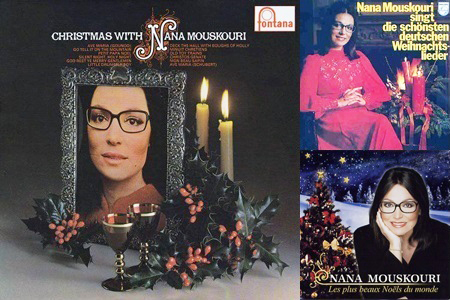
Christmas with
The first in a trilogy

THE FIRST OF THREE ALBUMS
Does it surprise you if I tell you that Christmas records sell very well and often have a long existence? This is true, however, even if you only listen to these songs for a short period of the year. "Christmas with", released in November 1972, is a good example. Not only did it respond to public demand, but it was also followed by two more. Let us review the content, its success in Canada, the various covers and the content variations until today.
1) THE CONTENT
Let's talk about its content first: twelve songs including six in English, three in French, two in Latin and one in Greek. As the album was produced in England, it could have been unilingual English. Probably to make it more versatile, more universal, it’s multilingual. André Chapelle ensured the realization and her ensemble, The Athenians, accompanies her in most of the songs.
Side 1
01- Ave Maria (Gounod) |
Side 2
01- Deck the hall with boughs of holly |
|
Very often, I have heard praise for "Minuit chrétien" and both "Ave Maria" which deserve contemplation for their quality of interpretation. It is true that when you close your eyes you can easily imagine yourself in a church. Her catchy version of "Go tell it on the mountain" from the gospel repertoire is pleasantly surprising. We can be proud that a Greek covers in the original language "Petit Papa Noël", the greatest success of French Chanson. What a pleasure to hear "Little drummer boy" again in a fifth language and to rediscover its magic! And what could be better than celebrating joyfully with "Christos genate", a heart-warming Greek folklore! These are just a few examples that have made it a success. You just have to listen to the whole record again to be convinced.
2) ITS SUCCESS IN CANADA
Although this opus came out in some 20 countries and eight tracks were released on 45 rpm discs, it was in Canada that it had the longest existence. In addition, its CD, released in 1988, has long been imported all over the world. For these two reasons, it appears interesting to note some highlights about it.
|
First of all, it should be mentioned that it sold very well on the English and French-speaking sides. In 1977, it earned her a gold record (50,000 copies) and in 1982 a platinum record (100,000 copies). As it went through several periods of transition (change of distributor, disappearance of vinyl records, cassettes and release on CD), it became difficult to follow its sales accurately. However, having seen it for decades in record stores, we can easily imagine that it sold between 3,000 to 6,000 copies every year during the weeks before Christmas. This suggests that it has undoubtedly achieved double platinum status (200,000 copies). |
Quebecers loved this record. As they got to know Nana thanks to her French songs, they would no doubt have liked an entire album in their language. On this matter, it should be noted that in addition to the three titles in French, there are four that can be found on other records. That being said, it was not uncommon that these versions were played on the radio. Particularly "L’enfant au tambour", both a Nana’s success and a Christmas classic, still available on 45 rpm. |
 |
3) THE DIFFERENT COVERS
As soon as the various franchises received the recordings, they released the LP and cassette. Each chose the cover that suited them. Does it have to do with the way they see this feast? Here are the main ones.
THE ORIGINAL
|
The album, conceived in England, came out as such in Canada, South Africa and Australia. With its framed photo, the cover reminds us of that of "Je me souviens". This time, the frame is part of a mistletoe leaves arrangement with two glasses of red wine and two candles. With its discreet lighting, it exudes an intimate atmosphere. Last striking detail: the capital "N" of her first name is decorated with flourishes. On the cantaloupe coloured back cover appear the song list and the same close-up photo. We can clearly see her special makeup with her eyelids decorated with glitters. |
THE WHITE In Holland, Nigeria, New Zealand and South Korea, they opted for a white cover, colour of snow, with a photo collage of Nana in a Christmas bauble. This one is taken from a TV show in which she wore a black dress decorated with multicoloured charms in front of a gleaming setting. On the back, the same graphic design as on the original album, but on a white background. The original and the white are the most common. |
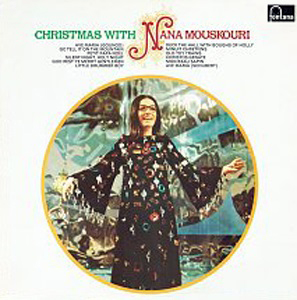 |
THE ASIATICS
In Malaysia and the Philippines, they inspired by the album "Pour les enfants" by using the cover photo on a silver background with snowflakes. It must be said that Christmas is also the children's day and that some of their songs are appropriate.
|
In Japan, a superb original cover was created. Itís a gatefold sleeve with the lyrics. The cover offers a winter view of the Church of St. Sebastian in Ramsau (Austria) and an illuminated tree. The content is the same, but the order of the songs is different. |
THE BLACK In 1985, PolyGram Canada decided to modernize the packaging by using that of the French jacket. On the cover: a dark photo with golden reflections. On the back cover: a painting of a crib. In South Africa, it was used to illustrate the compilation of various artists "The Gift of Christmas" with which the album is paired. |
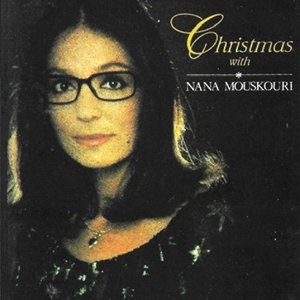 |
4) CONTENT VARIATIONS
Since its release, "Christmas with" made its way. Even the countries where the record is not pressed, it is imported. So that all over the world, Nana's voice can be heard on the radio during the holiday season. In some countries, the content has also been modified, adapted or enriched. Here are some examples.
|
GREECE When the time came, in Greece, they decided to make a French version of it, replacing five titles with French songs. The album begins with "Christos genate", the only Greek song. It was released in two versions. First, "Christougenna me tin" a red cover with a photo of Nana in concert. And, with the white cover that we know. |
GERMANY In 1974, Germany released its own version, "Singt Internationale Weihnachtslieder", with two songs in the national language. The subsidiary chose the cover with a Christmas bauble on a green background, the colour of the fir, to distinguish it. In the 1990s and 2000s, it will be reissued on CD with various covers under the title "Singt Weihnachtslieder aus aller Welt". |
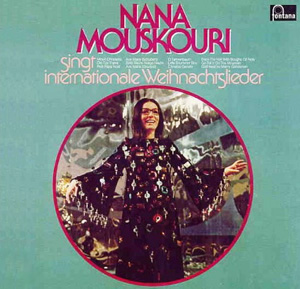 |
* THE SECOND ALBUM
In 1976 she recorded a second Christmas LP with songs from Germany which became one of her best sellers there: "Singt die schönsten deutschen Weihnachtslieder". The arrangements and the choice of instruments lead us to believe that it could be classified in the classical category. Note that her German Christmas repertoire is the most extensive.
|
FRANCE After the release of the EP "Chante Noël" in 1970, the French public had to wait ten years before getting their "Noël" album. It includes thirteen tracks including nine from the original album. It’s a black gatefold sleeve with the lyrics. On the cover, appears a close-up of Nana. In addition to their previous edition, Holland and Greece will release this new version. |
JAPAN In 1987, Japan was the first country to release it on CD. First, "Silent night, holy night" includes three bonus songs, then four. On the first edition, Nana appears in a medallion. On the second, there is no photo of her. Each includes a booklet with the lyrics. |
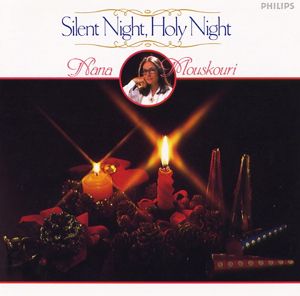 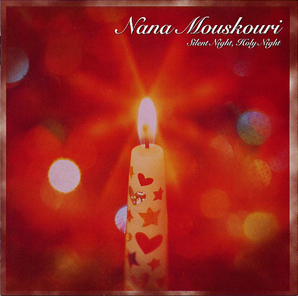 |
* THE THIRD ALBUM
In 2000, Nana decided to release a collection of 24 titles: "Les plus beaux Noëls du monde / The Christmas Album". It includes ten songs from the first album, of which some sung in other languages. Note that re-recordings and new titles have been added. Eleven of them weren't on the previous two albums.
50 YEARS
"Christmas with" is celebrating its 50th anniversary this year and is still one of her best sellers. At the time, it was designed according to the English and French speaking public to which she devoted herself. A few years later, Nana recorded a complete album in German. Then, songs in Spanish and Italian were added in her third collection. Let us hope that Nana continues to enrich her Christmas repertoire. Just with everything she has recorded in her career, there is enough to make a fourth album.